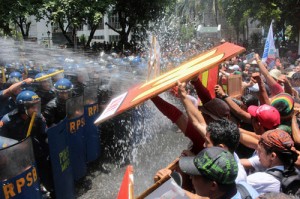US President Barack Obama returns from Asia with a major deliverable on the security side of the “pivot to Asia”: the enhanced defense cooperation agreement with the Philippines signed on Monday. Under the agreement, the US military will enjoy greater access to bases across the Philippines archipelago for a 10-year term. The agreement does not amount to a formal basing pact nor does it imply that US troops or other assets will be stationed in the Philippines permanently. The Constitution of the Philippines forbids the country from hosting a permanent US military presence or base.
According to the Associated Press, US troops would be deployed ”on temporary and rotational basis” to the Philippines. US Ambassador to the Philippines Philip Goldberg noted that the agreement will “promote peace and security in the region,” particularly by allowing US and Philippine forces to respond quickly to disasters.
In general, the agreement will allow the US Navy greater operational flexibility in the West Philippine Sea (South China Sea)—a sea that is slowly beginning to crowd with a profusion of ships and bases as protracted territorial disputes continue to cause concern across the region. The deal was motivated by the Philippines’ own concerns about possible Chinese aggression concerning the disputed Scarborough Shoal and the Second Thomas Shoal. In China, the deal will be seen as another brazen attempt at containment by the United States and the Philippines.
For the moment, the US and the Philippines are yet to make public the specific number of US troops that will be temporarily deployed in the Philippines as a result of the agreement. This number is likely to depend on planned joint activities between the two militaries. Further, while the deal will not require the US military to pay rent, Navy Times notes that the Philippines “will own buildings and infrastructure to be built or improved by the Americans and reap economic gains from the US presence.”
According to the Wall Street Journal‘s Southeast Asia Real Time blog, the US will gain access to Subic Bay, Cubi Point, Clark Air Base, Oyster Bay, Brooke’s Point and the Batanes Islands. The Batanes Islands, in particular, are an interesting vantage point for the US Navy, as they are just over 100 miles from the southern tip of Taiwan (about the same distance from Taiwan as Japan’s westernmost Island, Yonaguni, where the Japanese military recently deployed 100 troops and a radar installation).
Access to Batanes will prove useful should a crisis emerge in the Taiwan Strait or even the Diaoyu/Senkaku Islands.
In 1991, Filipino legislators voted to evict the United States military from Subic Bay and Clark Air Base. In 1999, after provocative actions by China, the Philippines allowed temporary passage and visitation to US ships and other military assets. In the past decade, US forces had been assisting the Philippine military in counter-terrorism preparation as the country has struggled with separatist Muslim militants.
Rhetoric
Meanwhile, a major Chinese newspaper hit out at Obama on Tuesday after the US president said Washington was not seeking to counter Beijing’s influence in Asia-Pacific.
The state-run China Daily wrote in an editorial that Obama’s week-long visit to Asia, which ended on Tuesday, made it “increasingly obvious that Washington is taking Beijing as an opponent.”
China’s claims to various islands, reefs and atolls in the South China Sea and East China Sea have been a constant theme of Obama’s tour of Japan, South Korea, Malaysia and the Philippines.
The trip has seen a US-Japan joint statement and a new US-Philippines defense agreement, and the paper wrote that while “from Tokyo to Manila, Obama has tried to pick his words so as not to antagonize Beijing,” his journey was “essentially about Washington’s and its allies’ unease about a rising China.”
At a joint news conference with Philippine President Benigno Aquino 3rd on Monday, Obama said while Washington did not take a position on the sovereignty of disputed territories, such issues must be addressed peacefully, not with “intimidation or coercion.”
He also said Washington has “a constructive relationship with China” and has no desire to contain or counter Beijing.
But the China Daily blasted those words as “hollow” rhetoric, warning that Obama’s “sweet promises of a new type of major-country relationship should not blind us to the grim political reality.”
“Ganging up with its troublemaking allies, the US is presenting itself as a security threat to China,” the paper wrote.
Shortly before Obama’s arrival in the Philippines on Monday, Washington and Manila signed a new defense pact that will insert US forces close to the volatile South China Sea.
Days earlier, the US and Japan issued a joint statement explicitly stating that islands at the center of a dispute with China are covered by the security alliance that obliges Washington to come to Tokyo’s aid if attacked.
Beijing responded with fury to both moves, and the China Daily maintained on Tuesday that the “foremost threat” was not China’s maritime disputes with Japan and the Philippines but rather “the threatening image of China” that the US and its allies were projecting.


